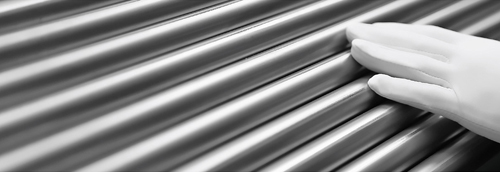Application of titanium tube in seawater desalination equipment
1.Heat-transfer tubes in seawater desalination equipment The original seawater desalination equipment heat-transfer tubes are mainly made of copper alloy tubes. Due to many deficiencies in copper alloy tubes, they have been replaced by highly reliable and maintenance-free titanium tubes. (1) Wall thickness of the titanium tube The wall thickness of the heat transfer pipe is determined by the conditions of use, the material of the pipe plate, the construction capability of the pipe expansion work, and the welding technology of the pipe end. Since the diameter of the heat pipe is small, the strength is not required so that it is actually used. The use of thin wall thickness of the pipe,, copper alloy pipe wall thickness of 0.9mm-1.2mm; replaced with titanium tube, in the corrosive place, the thickness of 0.3mm thin-walled pipe can be used.
2. Thermal conductivity of titanium tube Thermal conductivity is different due to the material of the heat pipe, such as 17W/(m•k) for titanium, lOOW/(m•k) for aluminum brass, and 47W for 90/10 white copper ( m•k), 70/30 cupro-nickel is 29W/(m•k), so the thermal conductivity of the heat pipe can be controlled by changing the wall thickness. In the above materials, titanium has the smallest thermal conductivity. If thin-walled titanium welded pipes are used, the thermal conductivity is lower than that of aluminum brass, but it is equivalent to 90/10 cupper and better than 70/30 cupronickel.
3. Titanium tube economical The unit price of titanium tubes is 2-6 times more expensive than that of copper alloys. However, from the viewpoint of cost performance, the price of titanium tubes can compete with copper alloy tubes. Since the density of titanium is low and the wall thickness is the same, the same length The quality of the titanium tube is only 50% of the copper alloy tube. When the titanium tube wall thickness is 50% of the copper alloy tube, the mass of the titanium tube with the same heat transfer area is only 1/4 of the copper alloy tube. According to the current price level, the overall price of thin-walled titanium welded pipes is the same as that of aluminum and copper pipes and is also cheaper than that of white copper pipes. Visible, titanium tube is competitive in terms of price.
Titanium tube should pay attention to the problem
(1) Galvanic corrosion Titanium has a more positive potential in seawater, and when in contact with other metals, it can promote the corrosion of other metals. Prevention methods include heat transfer tubes and tube plates using titanium or sacrificial anodes. Above 80°C, in order to prevent hydrogen absorption, a Fe-90% Ni alloy is used as a sacrificial anode; below 80°C, a coated or rubber-lined steel plate is used.
(2) Gap corrosion
The titanium tube is installed on the titanium tube plate by the expansion method. Gap corrosion can occur in seawater at pH value of 8 at 100°C. However, copper alloys are used in actual water chambers, and even if the seawater temperature reaches 120°C, no crevice corrosion will occur. In reality, in order to improve the reliability of the equipment, pipe end welding is often used to prevent gap corrosion when used above 100°C.
(3) Hydrogen absorption In seawater at temperatures above 80°C, titanium may absorb hydrogen; when cathodic protection is applied, over-protection will cause hydrogen absorption. If Fe-9%Nq alloy is used as sacrificial anode plate, hydrogen absorption by titanium does not occur.
(4) Vibration Due to the thin wall of the titanium tube, attention should be paid to the damage caused by the vibration of the tube when replacing the copper alloy tube. This problem can be solved by using a smaller spacing of the tube support plates than the copper alloy tube.

Attn : Jason
Email: jasontitanium@163.com
Skype: txcanberra

